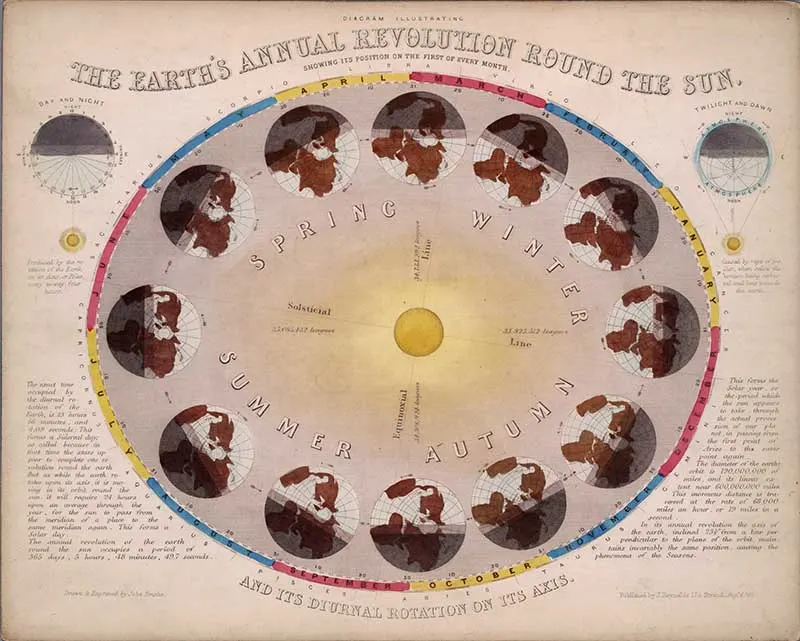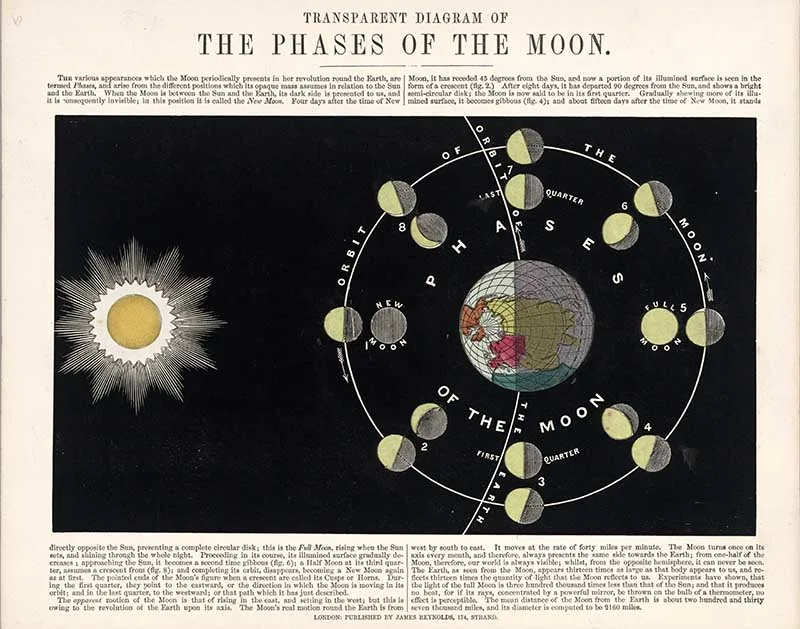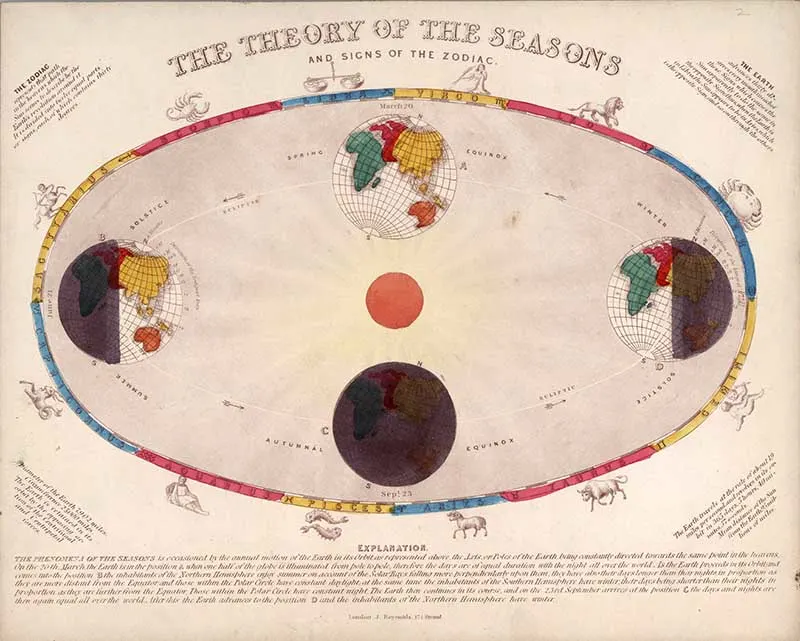Step back into the 1850s with John Emslie’s vintage astronomy prints and posters. These free-to-download celestial prints offer a glimpse into the universe’s wonders, perfect for any space lover!
In the 1850s, John Emslie and publisher James Reynolds teamed up to create some of the most stunning astronomy prints of the era. Whether you’re fascinated by stars and planets or love the beauty of old maps and illustrations, these prints capture the wonder and mystery of the night sky charmingly and timelessly. These beautiful works of art are in the public domain, which means they’re entirely free to download and print at your leisure!
If you’re familiar with my previous post on John Emslie’s vintage science posters, you already know how detailed and visually stunning his work is. His astronomy illustrations are no exception! And for those who enjoyed my collections of antique planetary and astronomical posters or constellation maps, you’ll find these celestial designs to be the perfect companion pieces.
Who Was John Emslie?
John Emslie was a talented British cartographer and artist known for his intricate and detailed scientific illustrations. While he worked on various subjects, his astronomy prints stand out for their clear depictions of celestial bodies, constellations, and planetary systems.
Published by James Reynolds, these prints were intended to educate and inspire curiosity about the universe. Imagine a time when astronomy was still a mystery to many, and these prints helped to bring the wonders of space down to Earth for everyday people.
Each poster is a snapshot of how people in the 19th century viewed the cosmos—and it’s fascinating to see how much (or how little!) our understanding has changed since then.
Why These Vintage Posters Are Still Amazing Today
Though created over 150 years ago, Emslie’s astronomy posters feel timeless. They offer a perfect mix of vintage charm and scientific exploration. Whether you’re decorating your home, classroom, or office, these prints can add a dash of retro science geekery and celestial beauty.
If you’re mainly into vintage star charts, don’t forget to check out my collection of antique zodiac star charts, which feature some similarly captivating celestial symbols.
How To Download The Vintage Astronomy Prints
Click on the title above the vintage celestial print you want, and a higher-resolution image will open in a new tab. Then, you can either print or save the image. All these prints are public domain, meaning you can print, frame, or use them however you like. Perfect for creating a vintage astronomy gallery wall or adding a little cosmic flair to any space.
All the prints are from ” Reynolds – Introduction to Natural Philosophy.”
Print 1 a: Telescopic Appearance of the Moon
The “Telescopic Appearance of the Moon” by John Emslie is a beautifully detailed, uncoloured print that offers a glimpse of the moon as seen through Lord Rosse’s telescope. The moon’s light surface is displayed against a darker background, capturing its craters and rugged landscape.
Text on the vintage astronomy print: “It appeared like a Glop of Molten Silver, and every object of the exact of a hundred yards was quite visible. Edifices, therefore, the size of York Minster might be easily perceived if that had existed. But there was no appearance of anything of that nature, neither was there any indication of the existence of water or of an atmosphere. There was a vast number of existence volcanoes several miles in breadth: though one of through on of them there was a line in continuance of one. About 150 miles in length which ran in a straight direction like a railway. The general appearance however was like one vast ruin of nature.”
Print 1b: Backlit Poster of the Moon
It is the exact poster above but illuminated from behind.
Print 2: The Earth And It’s Atmosphere
The hand-coloured astronomical diagram shows the Earth’s cross-section at the equator and the surrounding atmosphere. Various locations on the Earth’s surface are identified, and the diagram illustrates how the atmosphere can cause the phenomenon of refraction. It includes an explanation.
“The Earth is 24912 miles in circumference and 7,926 miles in diameter at the equator. Its surface contains 149 millions of square miles of water, and 49 millions of square miles of dry land. The depth of the ocean varies greatly, the inequality of its bed being fully as great as the inequality of the surface of the land. Of the interior of the Earth, beyond a few hundred feet from its surface nothing is known.
The surrounding Atmosphere extends from the surface of the Earth, where is most dense, to the height of about 45 miles. At the height of a few thousand feet, it becomes too rarefied to support life. In addition to its numerous other important qualities, it possesses the power of refraction, illustrations of which are shown in figures A and Be the first showing how a spectator observes the sun, while that body is yet below the horizon, the other the refractive effects at sea in particular states of the atmosphere.“
Print 3: The Earth’s Annual Revolution Round the Sun
The Earth’s Annual Revolution Round the Sun and Its Diurnal Rotation on Its Axis: This hand-coloured view illustrates the mechanism responsible for the Earth’s seasons as it makes its yearly passage around the Sun.
Print 4: The Sun and Solar Phenomena
This vintage planetary poster shows the Sun with several sunspots, illustrating the relationship between the Sun and Earth during the day and night and at different seasons. Small vignettes at the bottom illustrate Mercury’s transit, the Sun at Midnight at the North Cape of Europe, and an Annual Eclipse.
Print 5: The Central Sun and Theory of the Stellar Universe
Uncoloured views of the Sun, backed with translucent paper, to be illuminated from behind.
Print 6: The Transparent Solar System
Transparent Solar System: Displaying the planets with their orbits, as known at the present day. Derived from the latest and best authorities.
This hand-coloured, engraved solar system diagram features tissue paper backings and small holes in the card, allowing users to hold it up to the light and view stars, planets, and phases of the Moon illuminated against a darker background.
The central image predates Neptune’s inclusion, even though it was discovered in 1846; Neptune is mentioned in the accompanying text and table below. The diagram shows the planets with their known satellites, includes minor planets from the asteroid belt and features the orbit of Halley’s Comet. Notes and a list of planets are also provided.
Print 7: Transparent Phases of The Moon
The diagram shows both the phases, as seen from Earth, and the orbits of the Moon and Earth around the Sun. Text at the top and bottom explains these movements and appearances.
Print 8: Comparative Magnitudes of the Planets
It shows the comparative sizes of the planets, including Neptune, and depicts Saturn with its rings and the known satellites. And the relative distance from the sun.
A cannonball flying at the rate of 1000 miles an hour would take to reach the Sun, from Mercury 4 ½ years, Venus 8 years, Earth 11 ears, Mars 16 ½ years; Saturn 102 years; Uranus 205 ½ years, and Neptune 350 years.
The centre illustrates a comet’s eccentric orbit, demonstrating that the tail points away from the Sun. It is surrounded by the depiction of 12 comets, numbered with a key below. They are the comets of 1680 and 1741 (with six tails), 1811, Halley’s Comet, Encke’s Comet, and six images based on ancient sources.
Print 10: Elipcies with the Theory of Tides
Vintage astronomy prints showing the eclipse of the Moon, the Sun, and the Theory of Tides. The text at the bottom gives a fuller explanation of the theory of tides.
Print 11: The Theory of The Seasons and Signs of the Zodiac
This astronomical illustration shows the Earth’s annual rotation around the Sun, surrounded by a zodiacal scale that gives the zodiac signs’ names, symbols and images. The seasons and the positions of the equinoxes and solstices are marked. Text at the corners describes the Zodiac and the Earth, and a longer text at the bottom explains the Phenomena of the Seasons.
Print 12: Chart of the Heavens
Transparent Chart of the Heavens, for the Latitude of Great Britain, Shewing the stars visible on any night throughout the year.
“Find the day of the Month on the outer circle and the stars in a straight line with it, and the Pole-star in the centre will be on the meridian, or south, at nine o’clock in the evening, the relative positions of the other stars and constellations may then be readily traced. Nebulae of which a few representations are here given, are considered to be siderial firmaments each as expansive as that surrounding our system, but compressed by their immeasurable remoteness into a space, which at the largest to the naked eye a snow-flake will utterly conceal.“
Conclusion & Other Posts
John Emslie’s vintage astronomy posters are more than just educational tools from the past. They’re a window into a time when the mysteries of space were beginning to be uncovered. Whether you love science and history or want something beautiful to hang on your wall, these prints are a perfect way to bring a bit of cosmic wonder into your home.
Check out these beautiful antique zodiac prints on the site and find out how to use them to make fun personalized zodiac ornaments or tags. You may also enjoy this collection of Japanese zodiac sign prints.
If you liked these vintage astronomy posters, you’ll love this collection of old-school geography posters.
If you fancy, you can Buy Me A Coffee Here.














